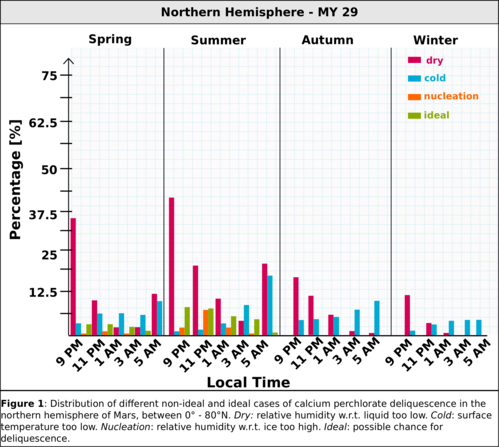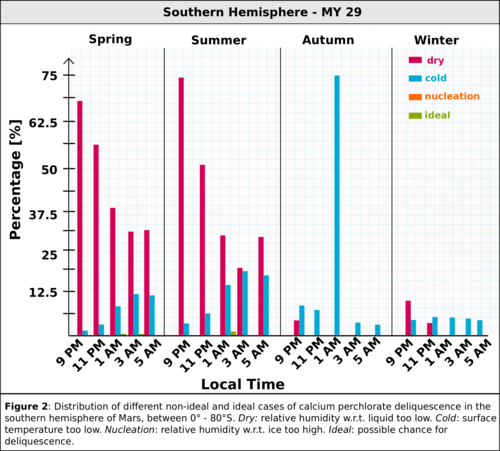Trends and key limiting factors of calcium perchlorate deliquescence on the surface of Mars
- 1Research Centre for Astronomy and Earth Sciences, ELKH, Hungary (pal.bernadett@csfk.mta.hu)
- 2Eötvös Loránd University, Budapest, Hungary
Liquid water is one of the most important component in the search for potential extraterrestrial life, with Mars being a high priority target. However, the present martian conditions do not allow large scale pure liquid water formation on its surface (Haberle et al., 2001); most of the studies point to ephemeral emergence (e.g. Brass et al., 1980; Knauth et al.; 2002; Mellon et al., 2000; Kereszturi et al., 2009}, but there are theoretical studies proposing a longer presence (e.g. Clow et al., 1987; Hecht et al., 2002). Transient formation of salty brines is a feasible candidate for water formation, as multiple martian rovers have already identified perchlorate salts on Mars (Hecht et al., 2009; Navarro et al., 2010; Leshin et al., 2013; Ming et al., 2014). Since perchlorates are hygroscopic, they can form aqueous solutions if the temperature and relative humidity is suitable through a process called deliquescence (Gough et al., 2011; Gough et al., 2014; Fischer et al., 2014; Nuding et al., 2014; Zorzano et al., 2009).
The relative humidity was calculated with surface temperature, atmospheric pressure and water vapor volume mixing ratio data from Laboratoire de Météorologie Dynamique Mars General Circulation Model (LMDZ GCM) version 5. This climate model is detailed in Hourdin et al. (2006) the second generation of the model described in the works of Sadourny et al. (1984) and Forget et al., (1999). The data were simulated for the Mars year 29. To derive the relative humidity with respect to ice and with respect to liquid, the saturation water vapor volume mixing ratio was calculated with an equation based on the Goff-Gratch equation (Goff & Gratch, 1946; List,1984). For the detailed calculations please refer to the methods section of Pál et al. (2020).
Consider the instances, when every necessary circumstances were met except for one. Summing these cases up and taking a look at the statistics, we can get a clearer picture of the limiting circumstances according to time and location (Fig. 1, Fig. 2). The local times taken into consideration were between 9 PM and 5 AM. The reason for this is that outside this time frame, the chance for deliquescence is considerably lower. The percentages are calculated with respect to every single location between 80°N - 80°S and time; for example 35 % of dry scenarios mean that compared to all instances (43 latitude gridpoints, 65 longitude gridpoints and 669 sols totaling 1 869 855 cases), 35 % of them (approximately 654 449) fell into the dry scenario.


If we examine the Mars year 29 and separate the data by hemispheres and by seasons, the data suggests that most of the time relative humidity is the primary limiting factor. Even though the temperature is above the necessary eutectic temperature, the relative humidity remains too low (dry scenario). This is a substantially more frequent case, than the instances, when either the relative humidity with respect to liquid is high enough with too low temperatures (cold scenario), or the relative humidity with respect to ice is too high, favoring nucleation instead of deliquescence (nucleation scenario).
Separating by seasons, the local spring and summer show much higher percentages of being too dry with sufficient temperatures. Besides, the local spring and summer in the northern hemisphere show the highest chance for deliquescence (ideal scenario) between 9 PM and 3 AM. There is a similar trend in the southern hemisphere, but with overall lower percentages and mostly between 11 PM and 3 AM. In the southern hemisphere between 1 AM and 5 AM the instances for too cold scenarios also increase, resulting in a 8-15 % chance.
There is one particularly interesting time, which is 1 AM in the southern hemisphere, during the local autumn. At this time the percentage for too cold scenarios is 74.6 %, an obvious outlier compared to all the other cold cases. If we take a look at a close-up between sol 1 and sol 194 at the southern hemisphere at 60°S, 1 AM local time, the relative humidity is elevated between sol 1 and sol 80, the beginning of the local autumn (Fig. 3). This elevation is visible at all latitudes, 60°S was selected as an illustration. Comparing the 1 AM data with 11 PM and 3 AM data, in the latter cases the relative humidity is still elevated at the beginning of the year, but not enough to stay above the necessary minimum level for calcium perchlorate. At the same time, the surface temperature remains strictly below the eutectic temperature (Fig. 4), thus we arrive at the 74.6 % of cold scenarios.
Overall the data suggests that relative humidity is the main limiting factor to deliquescence during local spring and summer in both hemispheres. The percentages, where surface temperature was high enough with relative humidity w.r.t. ice still low enough is considerably higher, than the other scenarios (too cold or nucleation). The northern hemisphere seems more favourable between 9 PM and 3 AM, while in the southern hemisphere between 1 AM and 3 AM are suggested as more ideal times. From the hemispherically and seasonally averaged data we can conclude, that the overall chance for ideal periods is still rather low, but usually not zero. Reviewing local “hot spots for deliquescence” might be a good follow up to these results.
How to cite: Pál, B. D. and Kereszturi, Á.: Trends and key limiting factors of calcium perchlorate deliquescence on the surface of Mars, European Planetary Science Congress 2021, online, 13–24 Sep 2021, EPSC2021-162, https://doi.org/10.5194/epsc2021-162, 2021.

